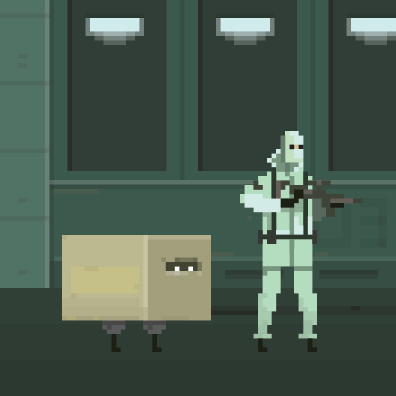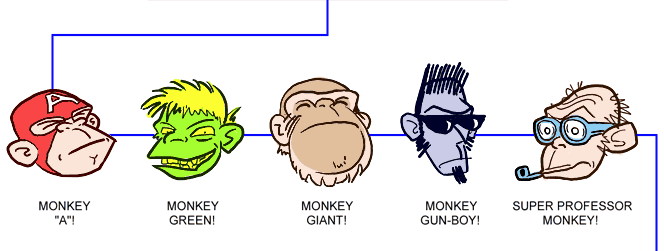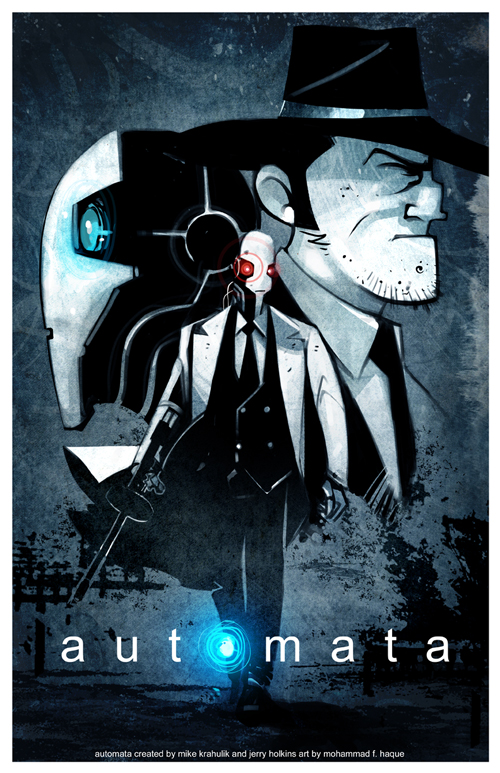My site is now handed in.
Independent Production Diary
Wednesday, 2 May 2012
Wednesday, 25 April 2012
Comic Structure
My comic treats the comic spaces as one that is split, each panel is treated as its own page. I think it would have been nice to have a continuous stream of content akin to the previous examples i have posted. But if I had done that it certainly would have made the sound elements more difficult, maybe even impossible to implement.
So, I've made this VERY simple mock up of a my comic in this style.
Thursday, 19 April 2012
E-Merl and Pup 15
http://e-merl.com/pocom.htm
http://www.drewweing.com/pup/13pup.html
Thursday, 12 April 2012
Scott McCloud on comics
McCloud talks about the evolution of comics from print media to a digital media.
He mentions Marshall McLuhan, who states that the medium will influence the form, but McCloud argues that with comics this doesn't happen and instead you will often get a traditional print style comic that just so happens to be on the internet. these comics are not influenced by their medium and are instead rigidly bound by previous craft practices.
He also mentions the spacial connection between comic panels and the ways in which tradtion print comics will often break their connection to the previous panel. McCloud suggests that the solution lies in ancient forms of sequential art, namely tapestries, ancient hieroglyphics and so on. He claims that the reader should be following an imaginary line, one that is unbroken, through the comic. With print media with becomes difficult as their are limitations of size and shape due to the need to conform to spaces with books and newspapers.
He brings up the monitor too, as limited as a page in some ways. But McCloud rather than think of the monitor as a static page see's it more as a window. He says that the monitor could potentially be an infinite canvas.
Saturday, 7 April 2012
Dead On Arrival
Friday, 6 April 2012
Scott McCloud Web-comics
The ideas are quite dated. But I feel some of what he says is still relevant today.
He is basically emphasising the difference between traditional print media and digital practises. I find it interesting that so few comics hosted online take advantage of their medium, which is extremely versatile.
Thursday, 5 April 2012
More Pixel Art
When your working with art work that is 25 pixel across you have to think carefully about each individual pixel as it can dramatically change the final product.
Tuesday, 3 April 2012
Superbrothers: Sword & Sworcery EP
The game also combines other forms of media into its design. the game encourages you to link your twitter account and tweet your achievements as you complete them in the game. also, character within the game will display their thoughts or disposition in a social network style interface.
Also, here's a dancing bear.
Monday, 26 March 2012
Tuesday, 20 March 2012
Loading screen
I feel that a loading screen gives the impression that their are systems at work behind what your viewing on your monitor. I thought a fake loading screen would help convey that the comic is inspired by video game forms.
Thursday, 15 March 2012
Wednesday, 14 March 2012
My Work
Again they are extremely simple, but I find even the simplest animation makes an images so much more interesting.
Monday, 5 March 2012
Weird Science
For inspiration I have been looking at some 'Weird Science' comic books. I really like the tone they produce and I'm keen to replicate it in my comic.
Here are some examples:
Saturday, 3 March 2012
Video Game Iconography
I've been thinking about the symbols and signs that are usually associated with gaming.
The most immediate obvious quality is their replication of spaces and figures. this can vary wildly from game to game, but the one I'm most interested in is gaming forms that rely on pixel graphics.
Pixel graphic are less common in gaming forms as they were in gamings early life cycle, and in contemporary gaming they are usually associated with smaller budget or deliberately nostalgic games.
it is this form visual style of gaming that I'm most keen on reproducing in my comic. As I've stated before I want my comic to be an interactive experience so its seems natural, to me at least, that I would use video gaming forms as the basis for my visual style. Pixel art also has certain practical advantages too. generally I find it much easier to animate and with my particularly low frame style of animation it looks aesthetically appropriate.
Wednesday, 29 February 2012
Animated Art
here's an example of an image that I feel benefits from animation.
Friday, 24 February 2012
Thursday, 23 February 2012
Music Choices and Star Control 2
I think this will give the project a transmedia quality.
For my tracks I'm using tracks from Star Control 2, Pokemon and the Legend of Zelda.
Star Control 2 has been a big influence in my project. I particularly like the conversations windows that the player uses to interact with the game's various alien creatures.
Here are two examples. Similar to my project this element of the game utilises looping animations.
Music link: http://downloads.khinsider.com/game-soundtracks/album/star-control-2-3do-
Saturday, 18 February 2012
David Carrier
'Tis only Causation, which produces such a connection a connexion as to give us assurance from the existence or action of one object, that 'twas follow'd or preceded by any other existence or action"
He brings up photography in relation to painting stating that a photograph is just one moment, one point in a sequence. but a painting does not need to necessarily need to depict just one moment in time.
Sunday, 5 February 2012
Thursday, 2 February 2012
Hosting For Website
Friday, 20 January 2012
Hobolobo
http://hobolobo.net/
I particualrly like the way the layers of depth shift when you view a new page.
Wednesday, 14 December 2011
Proposal
I propose to create a web comic, one that uses Mccloud’s definition of sequential art in order to create a product that fully utilises the medium of the web browser. I want to create a comic that spans three acts. Each act will embody a particular genre. The first act is a western but as the user advances into the second and third acts the genres will mix, hopefully producing something that is a fresh experience. I’ve decided to use a western as my primary genre, as I believe its elements can be easily combined with that of other genres. The second act will introduce science fiction conventions and finally the third will be a film noir/ crime thriller.
Structurally the site will consist of panels that are separated by html pages. Each panel can potentially contain animations, sound effect or music and interactivity. However for the final project I hope to expand and ultimately streamline the framework by reworking the comic to display on a slideshow. Not only will this make the site ‘cleaner’ but it will allow me to employ more sophisticated technics, for example flash games and more rewarding interactivity.
On top of the remediation of a traditional form, I want to explore how genre can be effectively replicated via its semantic elements. For the western this is simple enough. Within the first act all the action takes place in the saloon, a staple of the western. The genre can be further identified by clothing, character types, sounds and iconographic imagery and form. I aim to expand into different genre in the following acts. It will be interesting to see which genre can be identified most concisely by their semantic elements.
Ultimately I want my web comic to embody some the elements that only the web browser is capable of.
Work Schedule
Week 13-14:
I might not be able to do much production work at this time, as I have a presentation on the 30th of June which ideal I want to spend at least two weeks working on. To compensate for I will work on my production over the Christmas break. During this time I will be looking a examples of comic book art in order to develop a style for my own. I’m particularly fond of the 8 bit, pixel style. I think it would work well in my comic as I will be borrowing elements of video game play in my comic’s structure. Furthermore, pixelated art would make the animation process simpler.
Week 14-16
During these weeks I will be familiarising myself with flash. My ultimate aim is to retool the site, exporting the images onto a slideshow. Not entirely sure how complex this process will be but I feel two weeks is enough time. During this time I will be reading on up on more potential theorists. I’m slightly concerned that I won’t have another theoretical works to draw on that relate to web comics. Mccloud has proven very useful and I will be following up this interest by analysing his other books.
Week 15-19
These weeks will be spent drawing the images for my project at this moment in time I haven’t settled entirely on an art style. The pilot consisted of 11 images most of which had some form of animation. For the final project I want another two acts which mean 22 more images. I’m allotting a significant chunk of time to the illustration as they can take a while to complete. I also feel they are one of the more important elements of the site; they should be of a high standard.
Week 19-20
I will spend these weeks constructing the site. I should have the framework complete by this point. These weeks will consist of exporting the images to the slide show, building link and so on. If I have time I will begin to search for appropriate sounds to us e in the comic.
Week 20-21
During this time I will be continuing to source sounds for my site. On top of this I will begin researching for my final evaluation. I should complete a rough draft by the end of week 21.
Week 21-22
Work will likely slow down at this point as many assignments are due in the coming weeks. However the bulk of the leg work should be done by this point. The most time consuming aspect of this project is the illustrations, I feel I have assigned enough time to complete them.
Week 22-23
I will be working on polishing the site at this point. Most of the elements should be complete. I’ll need to find a suitable host for my site as well.
Tuesday, 13 December 2011
I’ve been thinking about comics and the ways it’s been remediated in various mediums. One of the more obvious examples is the transition from comic to film. When a comic is translated to a cinematic form it embodies all of its forms and technics, whilst the narrative elements remain the same the comic is changed on a structural level to accommodate the new medium. From what I’ve seen a large of amount of web comics conform to the limitation of its fundamental print format. Perhaps people believe that a comic should be defined by these limitations and to deviate from the status quo is to misrepresent a classic form. Artists may see the internet as a means to reach a wider audience, without considering what the medium is truly capable of. Or maybe it’s a matter of effort, it certainly easier to create a static page consisting of four panels. Jay David Bolter has the following to say in his book Remediation (1999).
'It is easy to see that hypermedia applications are always explicit acts of remediation: they import earlier media into a digital space in order to critique and refashion them. However, digital media that strive for transparency and immediacy (such as immersive virtual reality and virtual games) are also acts of remediation. Hypermedia and transparent media are opposite manifestations of the same desire: the desire to get past the limits of representation and to achieve the real. They are not striving for the real in a metaphysical sense. Instead, the real is defined in terms of the viewer's experience: it is that which evokes an immediate (and therefore authentic) emotional response. Transparent digital applications seek to get to the real by bravely denying the fact of mediation. Digital hypermedia seeks the real by multiplying mediation so as to create a feeling of fullness, a satiety of experience, which can be taken as reality. Both these moves are strategies of remediation. 43'
I believe this relates to my project, as I’m creating an experience that by Bolter’s definition is more ‘realistic in that I’m creating a comic that is ‘fuller’ than that of a print format.
The debate prompts the problematic nature of genres, whether in film, book or television. Theorists have attempted to define genres based on a number of different attributes, but they are usually inconclusive in their methods. Genre, much like the comic medium, is far too unruly a beast to effectively define. Its definition can change dramatically based on spatial and temporal factors, a Thai western is very different from an American western as would a western from the 1930’s would be different to one from the 2000’s. Similarly, comics can be thought of in the same way but only if you expand your definition of what constitutes a comic. In a previous post I referenced the beyeux tapestry as a potential example of a comic that predates the invention of the printing press. Similarly I want to challenge the preconceived ideas that define modern comics. I want to avoid sequential images separated by panels on a static page, but rather create an experience that utilises the medium of the internet.
In my comic I want to use explore both the framework of the comic and its possibilities and limitations as well as the possibilities and limitations that exist in genre. I want to see how icons, sounds, images, animation and interactivity can defy expectations in genre and comics.
Mccloud rejects the low brow consensus and instead proposes that comic books potential is ‘limitless and exciting!’.
In his effort to dismiss the claim that comic books are not worthy of a serious art form, Mccloud attempts to separate form from content, analysing not what is contained within but how the contents are presented, in Mccloud’s words: separating the message from the messenger. I feel this is particularly relevant to my project as I’m attempting to subvert preconceived convention of comic book forms and practises. However, mccloud’s definition of comic as sequential art has made me think that perhaps my animated panels are not so different from the classical form.
Mccloud states that comic books differ from animation because in animation the frames are separated by time and within a comic it’s separated by space. My comic attempts to combine both the temporal and spatial, the panels are separated by page and within those pages the panels contain animations. Mspaintadventures does the same:

Elements are separated by both spatial and via time in the form of separate panels and the use of animation.

Ultimately comic books are extremely difficult to define; they appear not only in the pages marvel and DC but arguably on elaborate tapestries and as ancient hieroglyphics. Mccloud debates whether the forms match up entirely but he acknowledges the similarities. I believe that these ancient forms could act as a possible precursor to modern day comics.

It’s not difficult to see the similarities that exist between this and more contemporary forms. Images are spatial in order to create a narrative. It does however lack panels, and is instead one continuous piece. The point I may illustrating is that the comic book form is capable of accommodating more than just pulp fiction. Indeed, ‘sequential art’ is found in many pieces of high art but rarely are these pieces referred to as’ comics’. It would appear that a comic carries with it an intricacy negative connotation, one that is defined not by form but taste. Mccoud himself cleverly subverts this idea by using comics as a medium for his ideas; he successfully uses what is generally perceived as a low cultural form to present theories and values that possess a high cultural capital.
Mccoud departs from his look on the past and instead casts his eyes on the future. By using Mcccloud’s definition of ‘sequential art’ it’s possible to open comic books to an almost unlimited range of possibilities, ones that don’t include superheroes or talking animals. In fact no one genre can, or should be, dominate using this definition, all have equal place on the comic framework. Furthermore, the aesthetic the technical process by which these comics are created is able to expand into area that may be seen as untraditional. Sequential art does not railroad the form into a ridged position wherein the comic can only exist as a low brow form with a standardised process of manufacture. Mccoud concludes by stating that these definitions are, by their very nature, evolutionary, an on-going process.
Dead Space Motion Comic

Monday, 12 December 2011
Mspaintadventures

Oktotally



Sunday, 11 December 2011
Scott Mccloud

Animated Comic Covers
Wednesday, 7 December 2011
 Here's is a image that will become part of my 'title page'. the idea is that each of the three acts of my comic will reflect a chosen genre. the first act is a western so 'Sal', our main character, is dressed in western trappings. Act two will be a science fiction, in act two I will attempt to blend the conventions of science fiction and the western. finally act three will begin to blend element of the film Noir.
Here's is a image that will become part of my 'title page'. the idea is that each of the three acts of my comic will reflect a chosen genre. the first act is a western so 'Sal', our main character, is dressed in western trappings. Act two will be a science fiction, in act two I will attempt to blend the conventions of science fiction and the western. finally act three will begin to blend element of the film Noir.(click image for full size plus animation)
Wednesday, 30 November 2011
Apple Patent Application Looks at Converting Video Game Play Into Comic Books



Saturday, 26 November 2011
Slide Shows?
Tuesday, 22 November 2011
Wednesday, 9 November 2011
Noir

http://penny-arcade.com/comic/2009/6/12
Blends Science Fiction and Film Noir conventions.



































